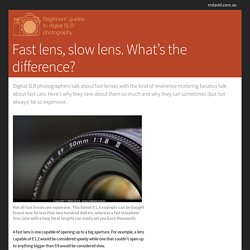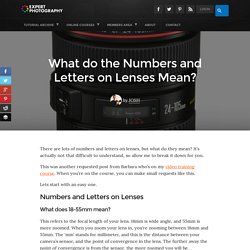

Patterns - NYTimes.com. I have had migraines for most of my life; the first attack I remember occurred when I was 3 or 4 years old.

I was playing in the garden when a brilliant, shimmering light appeared to my left — dazzlingly bright, almost as bright as the sun. It expanded, becoming an enormous shimmering semicircle stretching from the ground to the sky, with sharp zigzagging borders and brilliant blue and orange colors. Then, behind the brightness, came a blindness, an emptiness in my field of vision, and soon I could see almost nothing on my left side. 1 0f 3 David Hockney, The Lost Secrets of the Old Masters: camera lucida obscura. Broadcast Yourself. Annie Leibovitz: Life Through a Lens. Physics 11.3.1a - Lenses, Part 1. How Does a Camera Work? Best camera focus techniques: 10 surefire ways to get sharp photos.
One of the first rules of photography is that the subject should be sharp.

Most modern digital cameras offer a number of ways of achieving sharp photos, and in this post we’re going to look at the most important digital camera focus techniques and the best settings to use. We’ll look at how to select the AF point and which focus mode to use. Manual focus Although nearly all modern digital cameras can focus the lens automatically (the Leica M9, Leica M9-P and Leica Monochrom being notable exceptions) they also allow you to focus manually instead. Manual focus is a particularly good option with macro photography because many cameras struggle to lock onto very close subjects and the lens ends up hunting (moving in and out of focus) every time the shutter release button is depressed. It’s far less frustrating to switch the camera (or the lens) to manual focus and do the job yourself. Single shot autofocus Single focus mode is useful for static subjects such a s still life and landscapes. Choosing Where To Focus Part 1. Digital Photography 1 on 1: Episode 12: Depth of Field: Adorama Photography TV.
COSMOS Throwback Thursday: How Do Humans Recognize Patterns? On last week’s Cosmos: A Spacetime Odyssey, host Neil deGrasse Tyson explained how humans developed their eye for recognizing patterns.

Over centuries of of evolution, humans’ pattern recognition skills determined natural selection. Hunters skilled at spotting prey and predator and telling poisonous plants from healthy ones they had a better chance of survival than those blind to the patterns, enabling the survivors to pass on those pattern-friendly genes to future generations.
As it turns out, Carl Sagan pondered the same question on the original Cosmos, exploring how our brains process symbols and sounds to find commonalities. Sagan explores how the patterns on the backs of Heike crabs may have determined whether fisherman ate them or not – and why. Watch the video below, and tune in to an all-new Cosmos this Monday at 10P. DAVID HOCKNEY : PHOTOS / COLLAGES. Thursday, February 14, 2013. How To Set White Balance. Introduction to White Balance. A Post By: Darren Rowse White Balance is an aspect of photography that many digital camera owners don’t understand or use – but it’s something well worth learning about as it can have a real impact upon the shots you take.

So for those of you who have been avoiding White Balance – let me introduce you to it. I promise to keep it as simple as possible and keep what follows as useable as I can: At its simplest – the reason we adjust white balance is to get the colors in your images as accurate as possible. Why would you need to get the color right in your shots? You might have noticed when examining shots after taking them that at times images can come out with an orange, blue, yellow etc look to them – despite the fact that to the naked eye the scene looked quite normal. The range in different temperatures ranges from the very cool light of blue sky through to the very warm light of a candle. What is White Balance? Ever wondered why your subjects turn out yellow when photographing them in indoor environments?

Or why your camera flash can make them appear blue? Thoroughly understanding the concept of white balance and how it works is very important in digital photography, because setting it incorrectly could ruin a picture, adding all kinds of unwanted color casts and causing skin tones to look very unnatural. In this article, I will explain how you can adjust it on your camera or post-production to get accurate colors. 1) Definition of White Balance Simply put, white balance in digital photography means adjusting colors so that the image looks more natural. If you are a skier or a snowboarder, try this quick experiment: put on your ski goggles and look at the snow – it should change in color tone. While our brains automatically process the colors for us in such a smart way, digital cameras can only guess what the color temperature is by watching the ambient light. Fast lens, slow lens. What’s the difference? Not all fast lenses are expensive.

This 50mm f/1.8 example can be bought brand new for less than two hundred dollars, whereas a fast telephoto lens (one with a long focal length) can easily set you back thousands. A fast lens is one capable of opening up to a big aperture. For example, a lens capable of f/1.2 would be considered speedy while one that couldn’t open up to anything bigger than f/8 would be considered slow. Focal length comparisons - Luminous Landscape. Focal Length and Aperture Explained for the Photography Novice - Digital Photography Tutorials. Focal Length The focal length of a lens determines its angle of view, and also how much the subject will be magnified for a given photographic position.

Focal length also determines the perspective of an image. Longer focal lengths require shorter exposure times to minimize burring caused by the shake of hands. The Focal Length means how much can your camera see. Aperture The aperture range of a lens refers to the amount of light that the diaphragm can let inside the camera to reach the sensor. Re: Questions about fixed vs. variable focal length lenses: Beginners Questions Forum: Digital Photography Review. Hello, 1.

Enjoy! Digital SLR camera. Focal length comparison tool, Tamron USA. What do the Numbers and Letters on Lenses Mean? » Expert Photography. There are lots of numbers and letters on lenses, but what do they mean?

It’s actually not that difficult to understand, so allow me to break it down for you. This was another requested post from Barbara who’s on my video training course. When you’re on the course, you can make small requests like this. Lets start with an easy one. Numbers and Letters on Lenses What does 18-55mm mean? This refers to the focal length of your lens. 18mm is wide angle, and 55mm is more zoomed. If you’re confused by this at all, you can read all about focal length here.
What does 1:3.5-5.6 mean? This indicates the maximum aperture of your lens, which is how wide it will go, and ultimately how much light it will allow in. Sometimes you will see lenses which say 1:2.8. The reason the number is a ratio (1:), is because aperture is measured as a ratio. I personally look for lenses which don’t change the aperture as I zoom, but these can be a lot more expensive. DSLR Lens Primer: Part 2.
DSLR Lens Primer: Part 1.